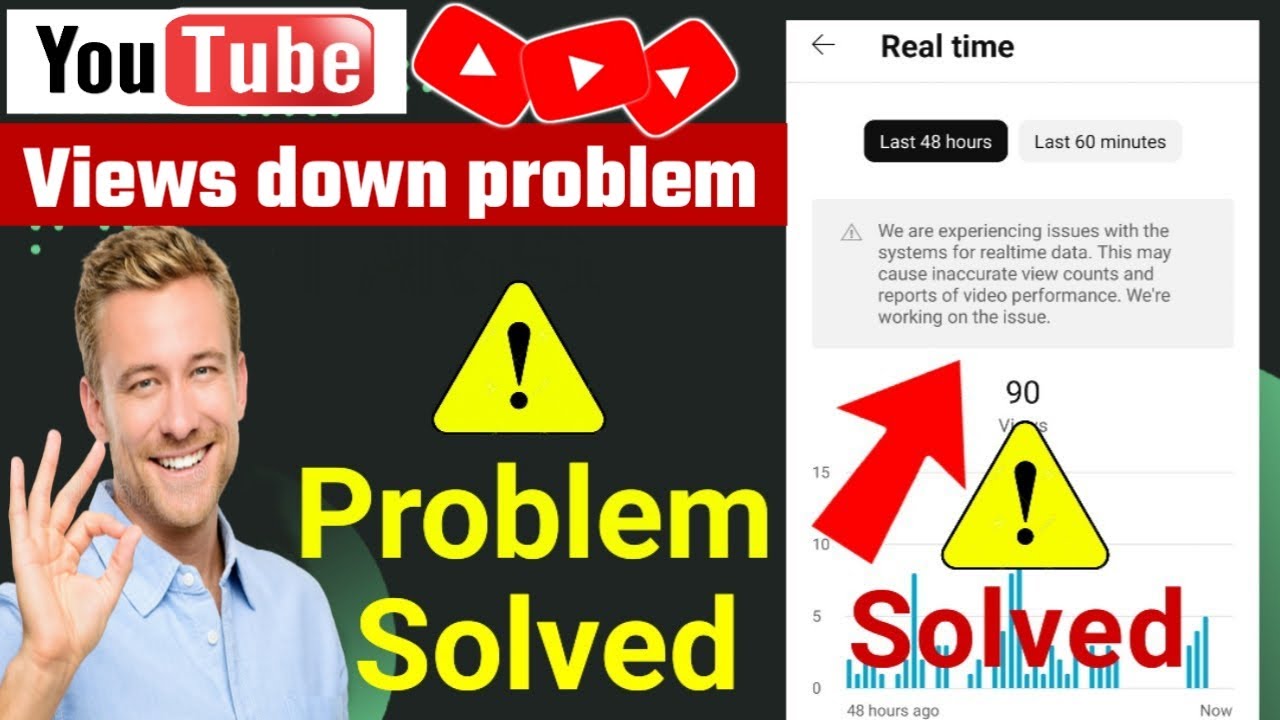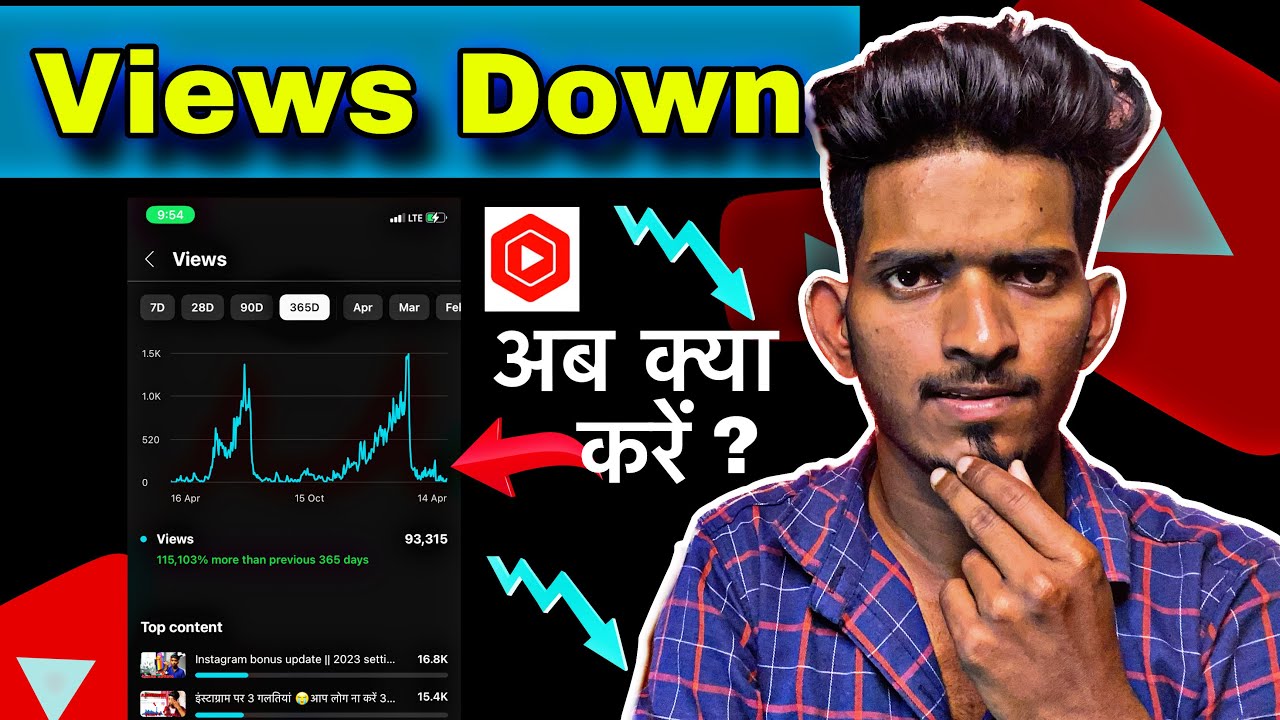As a content creator, seeing your YouTube views drop can be disheartening. You're putting in all that effort to create engaging videos, yet audiences seem to be tuning out. But don't worry, you’re not alone! This decline in views is a common challenge faced by many creators. In this post, we’ll dive into some of the most common reasons for this decline and share effective solutions to help you get back on track. Let’s get started!
Common Reasons for Declining YouTube Views

Understanding why your views might be dwindling is the first step to rectifying the situation. Here are some of the most common culprits:
- Inconsistent Posting Schedule: If you’re not posting regularly, your audience may lose interest. Consistency is key in maintaining viewer engagement.
- Content Saturation: The YouTube landscape is crowded. If your content isn't unique or doesn't stand out, it can get lost among the multitude of similar videos.
- Changing Algorithms: YouTube’s algorithm frequently changes, affecting how your videos are recommended. If your videos are not being promoted, views will drop.
- Poor SEO Practices: If you are not optimizing your video titles, descriptions, and tags for search, it’s possible that fewer people are discovering your content.
- Audience Disconnect: Your content may no longer align with what your audience wants to see. Keeping track of audience preferences can help maintain engagement.
- Lack of Promotion: Simply posting a video doesn’t guarantee views. If you’re not actively promoting your videos on social media or other platforms, you might miss potential viewers.
- Quality of Content: As you grow, production quality matters. If your later videos lack the quality of earlier ones, viewers may lose interest.
Let’s explore these reasons further:
Inconsistent Posting Schedule
Having a regular posting schedule builds anticipation and loyalty among your audience. If you post sporadically, viewers may forget about your channel. Aim for a consistent cadence—whether it’s weekly, bi-weekly, or monthly—to keep your audience engaged.
Content Saturation
With millions of channels out there, finding your niche is vital. If tons of creators are making similar content, find a unique angle or style that sets you apart. What unique value can you bring to your audience?
Changing Algorithms
YouTube’s algorithm can be unpredictable. Initially, your video may have gained traction, but as the algorithm shifts, it may no longer recommend your content. Stay informed about changes and adapt your content strategy accordingly.
Poor SEO Practices
Are you effectively utilizing SEO? Research keywords related to your content and integrate them into your titles and descriptions. This can improve your discoverability significantly.
Audience Disconnect
Feedback is key! Use polls, community posts, or comment sections to gauge what your audience wants. Staying attuned to their preferences can inform your future content strategy.
Lack of Promotion
Don't solely rely on YouTube for views. Share your videos on platforms like Instagram, Twitter, and Facebook. Engage with communities that relate to your content and promote your channel.
Quality of Content
As you evolve as a creator, it’s crucial to maintain or increase video quality. Invest in better equipment or editing software if necessary. Your audience deserves the best, and higher-quality content can keep them returning.
Now that we’ve pinpointed some of the common reasons for the decline in views, with some actionable solutions, you're one step closer to revamping your content strategy and regaining your audience’s attention! Stay tuned for more insights!
Also Read This: How to Find the Email from a YouTube Channel for Business Inquiries
The Importance of Audience Engagement

When it comes to YouTube, engagement is king! If you find your views declining, one of the first places you should look is your audience engagement levels. After all, it's not just about creating content; it's about creating a community.
What is Audience Engagement? Simply put, audience engagement refers to the ways in which your viewers interact with your videos. This includes likes, comments, shares, and subscriptions—these actions show that your audience is not just passively watching but actively participating in your channel's community.
Why is this so important? Well, engagement can significantly affect your video's visibility. YouTube's algorithm favors videos that have higher engagement rates. The more viewers interact with your content, the more likely it is to be recommended to others. Here are three key elements of audience engagement you should focus on:
- Encouraging Comments: Don't be afraid to ask your audience to leave their thoughts or questions in the comments! Posing an open-ended question at the end of your video can spark conversations.
- Responding to Comments: Take the time to reply to comments on your videos. A simple “thank you” or a thoughtful response can foster a sense of community.
- Interactive Content: Consider creating polls or quizzes and encouraging viewers to participate. This not only boosts engagement but can also provide you with valuable feedback for future content.
Remember, fostering engagement is not just about numbers; it's about creating a loyal fanbase. When viewers feel connected to you, they're more likely to return to your channel and share your content with others.
Also Read This: How to Post YouTube Clips on Instagram Like a Pro
Evaluating Your Content Strategy
A drop in views can often signal a need to reassess your content strategy. If you’re consistently producing high-quality videos but aren’t seeing the desired audience growth or engagement, it might be time to evaluate your approach. Here are some aspects to consider in your content strategy review:
Know Your Audience: Understanding your audience is crucial. What are their interests? What problems or questions do they have that you can help solve? Use tools like YouTube Analytics to gather demographic information, watch time statistics, and more to tailor your content to meet your viewers' needs.
Content Scheduling: Consistency plays a significant role in audience retention. Look closely at how often you're posting and whether it aligns with your audience's expectations. Consider creating a content calendar to keep track of your posting schedule and ensure variety in your content.
Experiment with Formats: If you've been sticking to a particular format, it might be time to shake things up! Try different video styles such as tutorials, vlogs, interviews, or live streams to see what resonates with your audience. Each format can bring a unique way to engage your viewers.
Review Audience Feedback: Don’t ignore viewer comments and feedback. Pay attention to what your audience loves and what they seem to skip over. This feedback is invaluable for future content decisions.
Finally, don't be afraid to adjust your content strategy based on what the analytics tell you. Flexibility can be a game-changer in the ever-evolving world of YouTube. Keep experimenting and learning from your audience to stay relevant and maintain your viewership!
Also Read This: How Many Viewers Does Dr Disrespect Get on YouTube and What’s His Audience Size?
5. Optimizing Video Titles, Descriptions, and Tags
When it comes to YouTube, the difference between a video that flops and one that goes viral can often be found in its titles, descriptions, and tags. These elements are your first impression, and you want to make sure they are both enticing and informative.
Let's start with titles. Your title is essentially a mini-advertisement for your video, and it needs to grab attention while also being relevant. Here are some tips:
- Be specific: Instead of a vague title like "Cooking Tips," try something like "5 Easy Cooking Tips for Busy Moms."
- Use keywords: Research keywords that your target audience is searching for and incorporate them into your title. Tools like Google Trends or YouTube's search bar can provide insights.
- Keep it concise: Aim for a title between 50-70 characters for optimal visibility on search results.
Next up, the description. This is your chance to provide context about your video. Use this space wisely to enhance engagement and discoverability:
- Start strong: The first two lines of your description appear in search results, so make them impactful. Include key information that will compel viewers to click!
- Include links: Whether it’s to your social media, other videos, or a blog, add relevant links to keep viewers engaged with your content beyond the initial video.
- Use timestamps: If your video is longer, consider adding timestamps in the description to highlight different sections. This helps viewers navigate your video and stay engaged.
Finally, let’s talk about tags. Tags help YouTube understand the content and context of your video, which can improve your visibility:
- Use a mix: Include a variety of tags, from broad terms to specific keywords that directly relate to your video. Think of what your potential audience might type into the search bar.
- Limit your tags: While it can be tempting to add as many tags as possible, focused tags—think 5-15 relevant keywords—are more effective.
By carefully crafting your titles, descriptions, and tags, you're not just improving your search ranking but also enticing viewers to click and engage with your content. So, take the time to refine these elements, and watch your views start to climb again!
Also Read This: Did Kwite Quit YouTube? Analyzing Kwite’s Absence from YouTube and Future Plans
6. Leveraging Social Media for Increased Exposure
Social media is an incredibly powerful tool for driving traffic to your YouTube channel. If you’re noticing a decline in your views, it might be time to beef up your social media strategy. Let's dive into some effective ways to leverage these platforms.
First, share snippets or trailers of your videos on your social media platforms. For example, post a 15-30 second teaser on Instagram or TikTok that highlights the best moments of your video. This encourages your followers to check out the full version on YouTube. Here are some platforms to consider:
- Instagram: Use Stories, Reels, and your feed to create engaging content that leads to your video.
- Facebook: Share a post on your personal or business page and encourage discussions—ask questions related to your video topic to spark engagement!
- Twitter: Tweet links along with engaging captions or questions about your video to get your followers interested.
Another effective tactic is to join relevant groups or forums. Participate in discussions that relate to your content, and share your videos when relevant. But remember, being genuine and adding value to the community is key. If you’re just spamming links, you’re likely to be ignored or even reported.
Consider using hashtags strategically. Research popular and relevant hashtags related to your video content to increase its visibility on social platforms. For example, if you create travel content, hashtags like #TravelVlog or #Wanderlust can help you reach an audience interested in those topics.
Finally, collaborate with other creators. Partnering with others in your niche can expose you to new audiences. You can create joint videos, or feature each other’s work on your social media. It’s a win-win for both parties!
By harnessing the power of social media, you can create a multi-channel approach that not only increases your video views but also builds a community around your content. So, get out there, engage, and start sharing!
Also Read This: Can't Access YouTube on Mobile Web? Troubleshooting Mobile Web Access Issues
7. Analyzing and Adapting to YouTube’s Algorithm Changes
Understanding the YouTube algorithm is crucial for any content creator looking to maintain and even boost their views. YouTube's algorithm isn't static; it evolves frequently, affecting how your videos are recommended and discovered. Here’s how you can keep your finger on the pulse and effectively adapt:
Stay Updated: YouTube occasionally shares updates, insights, and best practices through their Creator Academy and official blogs. Following these resources can help you stay informed about what the platform is emphasizing at any given time.
Monitor Performance Metrics: It's vital to pay attention to how your videos perform over time. Key metrics such as watch time, engagement rate, and click-through rate can give you a good indication of how well you're meeting the algorithm's requirements. If certain videos perform poorly, it may be time to rethink your strategy.
Focus on Retention: One of the most significant factors in the algorithm is audience retention. If viewers are dropping off early in your videos, the algorithm may take that as a sign that the content is not engaging enough. To combat this, consider:
- Hooking your audience in the first few seconds. Start with an intriguing question or a quick summary of what they'll learn.
- Incorporating engaging visuals, storytelling, or high-quality editing.
- Using chapters in your videos to help viewers navigate and find sections that interest them.
Adapt Content Strategies: If you notice a decrease in views, it could be an opportunity to pivot your content strategy. Analyze which types of videos have performed well in the past and incorporate similar themes or formats. This doesn’t mean completely changing your style, but rather tweaking it to align with viewer preferences and algorithm trends.
Finally, don't forget to engage with your audience. Encourage comments and interactions, as this engagement plays a crucial role in boosting your visibility on the platform. Remember, YouTube wants to promote videos that foster community and interaction. By staying aware of algorithm changes and adapting your content accordingly, you can help ensure a steady flow of views and engagement.
Also Read This: Why Is My YouTube TV Not Working and How to Troubleshoot Common Issues
8. Utilizing YouTube Analytics for Insights
Your best friend when it comes to understanding your audience and improving your content strategy is YouTube Analytics. This powerful tool provides a wealth of data that can illuminate many aspects of your channel's performance. Here’s how you can effectively utilize it:
Understand Your Audience: YouTube Analytics offers demographic insights about your viewers, such as age, gender, and geographic location. This data is priceless when tailoring content that resonates with your target audience. For instance, if you discover that a significant portion of your viewers are from a particular region, you might consider creating content relevant to that area.
Assess Traffic Sources: Knowing where your views are coming from is crucial. Are most of your views coming from search results, suggested videos, or external sources? By identifying traffic sources, you can effectively target and optimize your promotion strategies. For example, if you find that a lot of traffic is coming from social media, you might decide to focus on your marketing efforts there.
Analyze Viewer Behavior: Metrics such as watch time, average view duration, and audience retention can tell you a lot about how engaging your content is. If viewers leave your video after only a few seconds, that’s a red flag. Use this data to pinpoint where people drop off and consider adjusting your future content accordingly. For instance, try to keep the beginning of your videos concise and engaging to improve retention.
Track Changes Over Time: Don’t just look at your analytics sporadically; make it a habit to review them regularly. Look for trends over time. Are certain types of content consistently outperforming others? This could guide your future content planning and help identify what resonates best with your audience. Regularly charting your progress can also motivate you and help you remain consistent in your content creation.
Set Goals and Analyze Performance: After gathering insights from your analytics, set specific, measurable goals for your channel. For example, aim to increase your average view duration by a certain percentage within a few months. Regularly compare your performance against these goals to gauge your progress. Consistency is key, and setting goals helps keep you accountable.
Utilizing YouTube Analytics is not just about monitoring numbers; it's about cultivating an understanding of your audience, refining your strategies, and ultimately growing your channel. The more you dive into the data, the better equipped you’ll be to adapt and thrive in the ever-changing landscape of YouTube!
Also Read This: How to Get YouTube Mini Player on Other Tabs for Multitasking
9. Implementing Best Practices for Video Quality
So, you’ve put in the effort to create content, but if your video quality is lacking, it might fall flat with viewers. People are incredibly visual, and a polished product can make a huge difference in engagement. Here’s how you can elevate the quality of your videos:
- Invest in Good Equipment: You don’t need to break the bank, but a decent camera and microphone can significantly improve your video and audio quality. Consider your lighting, too; natural light is fantastic, but softbox lights for indoor shooting can do wonders.
- Focus on Editing: Editing goes beyond just cutting the bad bits. Use software to refine your content, add graphics, or enhance audio. Freely available tools like DaVinci Resolve or Shotcut can get you started.
- Optimize for Mobile: Since a large portion of YouTube traffic comes from mobile devices, make sure your videos are optimized for mobile viewing. Use vertical framing when necessary, and ensure text is readable on smaller screens.
- Aim for Higher Resolutions: At minimum, shoot in 1080p. Higher resolutions like 4K give a more immersive experience and are favored by the algorithm, which may help boost your video in search results.
- Sound Matters: Believe it or not, poor audio can drive viewers away faster than shoddy visuals. Consider investing in a good microphone, and always do a sound check before recording.
Implementing these best practices doesn’t have to happen overnight. It’s a gradual process, but if you focus on improving the quality of your videos step-by-step, you’ll likely see a positive impact on your views over time.
Also Read This: How Much Data Does YouTube TV Use for Streaming Costs and Usage
10. Building a Community Around Your Channel
Growing a YouTube channel isn’t just about uploading content; it’s about fostering a community. A loyal viewer base can be your greatest asset, keeping engagement high long after the initial video release. Here are some effective ways to build a community:
- Engage with Your Audience: Respond to comments, ask for feedback, and create polls to understand what your viewers want to see. This interaction makes them feel valued and can lead to more subscribers.
- Create a Unique Brand: Having a consistent brand identity—from thumbnails to video intros—helps establish recognition. Your audience should know it's your video just from the visuals.
- Utilize Social Media: Promote your videos on platforms where your audience hangs out. Create content specifically for those platforms that loops back to your YouTube channel; this helps bridge the gap.
- Host Live Streams: Live interactions can significantly increase viewer connection. Try Q&A sessions, behind-the-scenes looks, or fun gaming livestreams to keep your audience engaged in real-time.
- Encourage User-Generated Content: Invite your viewers to share their content related to your channel. Whether it’s challenges, artwork, or reviews, showcasing their contributions can create a sense of belonging.
Remember, building a community is a two-way street. The more you invest in your audience, the more they’ll invest in you. As you nurture this relationship, you can foster a vibrant community that returns for each new release!
Conclusion
In conclusion, experiencing a decline in YouTube views can be disheartening for content creators. However, understanding the reasons behind this decrease is crucial to reclaiming your audience's attention. Here are some key takeaways:
- Analyze Your Analytics: Use YouTube Analytics to identify trends, traffic sources, and audience retention rates.
- Content Relevance: Ensure your content aligns with the interests and expectations of your target audience.
- Optimize Thumbnails and Titles: Catchy thumbnails and engaging titles can significantly improve click-through rates.
- Consistency is Key: Regular uploads can help maintain viewer engagement and attract new subscribers.
- Engage with Your Audience: Responding to comments and fostering a community can encourage viewers to return.
Implementing these strategies can not only help address the decline but also enhance overall channel performance. Remember, adapting to changes in viewer behavior and staying updated with YouTube’s evolving algorithms is essential for sustained growth. By focusing on quality content and engaging with your audience, you can revive and even boost your viewership over time.
 admin
admin








